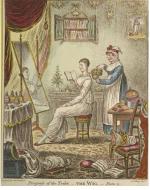Created by Cynthia Honeycutt on Mon, 10/07/2024 - 10:18
Description:
Despite the simplistic silhouette favored in Jane Austen’s time, there were still layers of undergarments to make the look successful as depicted above in Gillray’s Progress of the Toilet. The first panel, “The Stays,” depicts a maid helping her mistress into her stays, over her chamise, and stockings. The second panel, “The Wig” displays the mistress in her petticoat and dressing gown, or in “undress” while the maid prepares her wig. The final panel, “Dress Complete,” has the mistress fully dressed in “full dress” or evening wear with her maid holding her shawl and fan (Davidson). This short series of etchings displays the layers of undergarments necessary for a fashionable woman in the Regency era to dress.
In the 1780s, there was a shift in women’s undergarments that changed the popular silhouette from the structured hourglass of the mid-1700s to the Neoclassical gowns of the Regency period. Due to a resurgence of the neoclassical influence, a change in waistline led to a change in stays. Stays, predecessors to the corset, the main purpose went from shaping the waist to elevating the breast in women’s dress. To achieve this purpose, the stays became shorter, and started using cording instead of whalebone to obtain the structure of the garment. Over the era, there were additions and modifications to the stays to greater achieve the silhouette such as hip gussets and princess seam cuts (Sholtz). The stays were always worn over a chamise, also known as a shift, which was a simple linen undergarment used to protect the clothing from the skin and vice versa. As shown in the second panel, the petticoat would go over the stays and be used to both provide volume to the skirt and further protect the main outer garment, or gown petticoat (Davidson). The popular silhouette of the Regency period called for a shift in the undergarment-making industry in order to achieve the desired appearance, and as fashions change, so does what is worn underneath.
Work Cited
Davidson, Hilary. Dress in the Age of Jane Austen. Regency Fashion. New Haven, Yale University Press, 2019.
----. Jane Austen’s Wardrobe. New Haven, Yale University Press, 12 Sept. 2023.
Gillray, James. Progress of the Toilet: Plate 1: The Stays; Plate 2: The Wig; Plate 3: Dress Completed (Hannah Humphrey, 1810). Etchings. © The Trustees of the British Museum. https://jasna.org/assets/Persuasions-On-Line/Vol41-No1/Sholtz-Zohn/Figur...
Sholtz, Mackenzie. ““A Staymaker of Edinburgh”: Corsetry in the Age of Austen» JASNA.” Jasna.org, 2020, jasna.org/publications-2/persuasions-online/vol-41-no-1/sholtz-zohn/#Figure-26. Accessed 16 Oct. 2024.
Copyright:
Associated Place(s)
Part of Group:
Featured in Exhibit:
Artist:
- James Gillray


